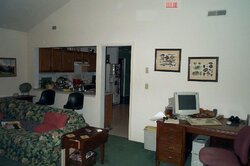I was explaining to a coworker about how my woodstove heat tends to stay in my den with the vaulted ceiling. He suggested I cut a vent higher up on the peaked part of the wall to let captured heat flow into the upstairs. Attached is a diagram. I drew a red vent up on the wall where this could be done. A spare bedroom is on the other side of that wall. The vent would be on the lower part of this bedroom wall. I would try to use vents that look like the existing ones used by my heatpump ductwork. He said this would aid in establishing a convection flow where cold air would flow into my very warm den as warmed air flowed through the vent into the upstairs.
I'm not trying to tie this in with my ductwork. This would be a pass-thru. And I do already have a ceiling fan in this room as well as a small box fan forcing cool air into this room (so that it spills out the top of the doorway and the kitchen opening). I could just use more help distributing the heat.
Craziness?
I'm not trying to tie this in with my ductwork. This would be a pass-thru. And I do already have a ceiling fan in this room as well as a small box fan forcing cool air into this room (so that it spills out the top of the doorway and the kitchen opening). I could just use more help distributing the heat.
Craziness?


